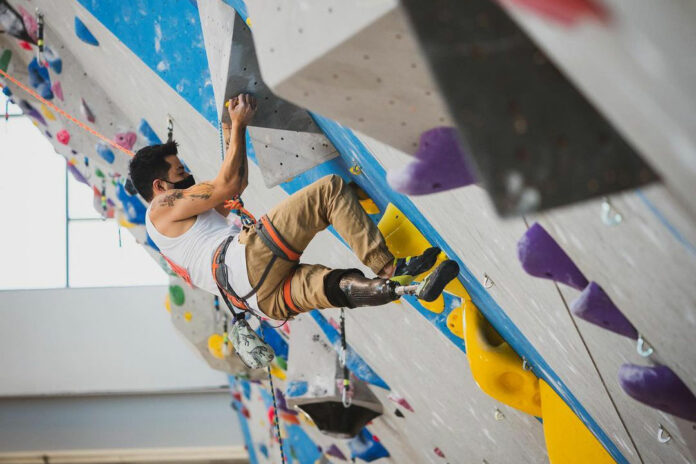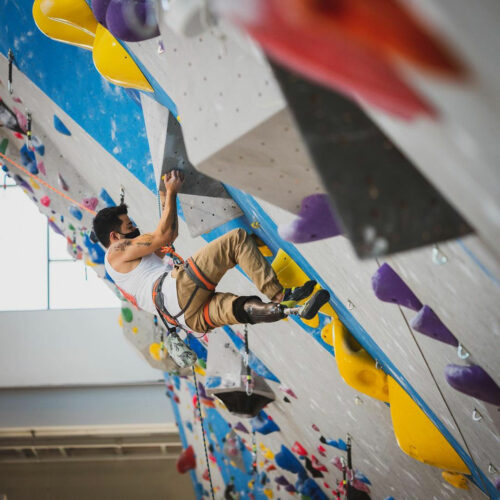
When it comes to the development and progression of climbing, one of the most exciting areas of innovation and growth is paraclimbing. Paraclimbers, who are also referred to as adaptive climbers, are athletes who climb with an impairment. Impairments can include a leg or arm amputation, a visual impairment, a neurological or muscular disorder, partial paralysis, and many other conditions. The competitive scene for paraclimbing is still very new, with the first IFSC Paraclimbing World Championships occurring in 2011. Each year, athletes are pushing the limits of what is possible in the sport—from dynamic moves for blind climbers to technical full-route campusing, and everything in between.
Creating inclusive environments for adaptive climbers has many avenues, and one way is for a gym to be deliberate and thoughtful in routesetting for this community. To dive into the scene of setting for paraclimbers, I sat down with two USAC Level 5 National Chief routesetters, Mark Mercer and Nohl Haeckel, and USA Paraclimbing National Team athlete Jake Sanchez. Mercer is the Head Setter at Momentum SODO in Seattle and is an IFSC Paraclimbing Routesetter who chiefed the 2018 IFSC Para World Championships in Innsbruck, Austria. He most recently set for the Para World Cup in Salt Lake City in May, 2022. Haeckel is the director of setting at Flowstone Climbing in Redlands, CA, and an IFSC Paraclimbing Routesetter, and he has been setting USAC Paraclimbing National events since 2018. Sanchez is a coach, routesetter, and assistant manager at Rockreation in LA, who has a long resume of National and International competitions and podium finishes, including a 2nd place finish at the 2021 IFSC Para World Cup in Los Angeles.
In this article, we will dive into setting for paraclimbing by looking at the competitive scene—but it’s important to note that paraclimbing is not limited to competitions. Far from it! Around the world, more and more local adaptive communities are springing up at neighborhood gyms, and routesetters are being tasked with setting climbs that foster growth for this community, whether the athletes are aspiring or seasoned competitors or newbies trying their very first climbs. Put simply, the principles behind competition setting are very applicable to commercial setters and commercial gyms.
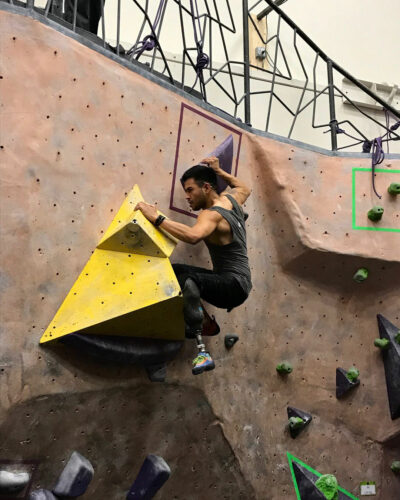
Setting for Paraclimbing is Like Any Other Type of Setting
Haeckel notes that the routesetting process for paraclimbing is really no different than any other type of setting. “You’re setting for a group of people, it’s just a different group of people,” he says. “You’re just ultimately deciding whether this group of people is capable of doing this rock climb, or this section of the route, based off their ability.”
Simply having routes on the wall is a great place to start for introducing adaptive athletes to climbing. “All routes can be beneficial to an adaptive climber, not just those intentionally set for them,” says Mercer. “They don’t want to be relegated to the back corner of the gym where a few intentional routes were set specifically for them. They will have their own unique challenges/cruxes on any route in the gym, same as any climber.” Maintaining that mentality in a local gym environment is crucial to fostering a healthy, inclusive environment. To piggyback on this idea, famed USA paraclimber Mo Beck commented on gym routes for paraclimbers in a previous CBJ article. “Most adaptive climbers can just climb regular routes, but a few can benefit from intentional routesetting.” To dive deeper into the nuances of the craft, this article talks largely about what that “intentional routesetting” can look like.
Sanchez notes that, from an athlete perspective, it’s essential that routes are created which challenge and test the athletes. “The point is that you’re trying your hardest at high levels,” he says. Just like the process for setting for youth or local competitions, routesetters have to know who they are setting for and apply their knowledge of body mechanics and movement, visualizing climbers on the wall, and tweaking effectively in order to meet the abilities of those climbers and provide fair and challenging routes. “You just have to know [who you’re setting for] and what their strengths and weaknesses are,” Mercer says. “That being said, paraclimbers have very different strengths and weaknesses from able-bodied climbers.”
Some setters might yearn for a specific, formulaic playbook for setting for paraclimbers, dictating exactly which holds, movements and sequences to set for athletes with each disability. That playbook doesn’t exist—just like it doesn’t exist for setting for other climbers. Just like every gym demographic is different, each paraclimbing community is different as well; in their disabilities, movement capabilities, reasons for climbing, and view on what “climbing development” means to them. In order to become an effective setter for paraclimbers, a setter needs to understand the paraclimbing categories, learn how to effectively forerun, manage climber safety, and get to know their community so they can understand who they are setting for.
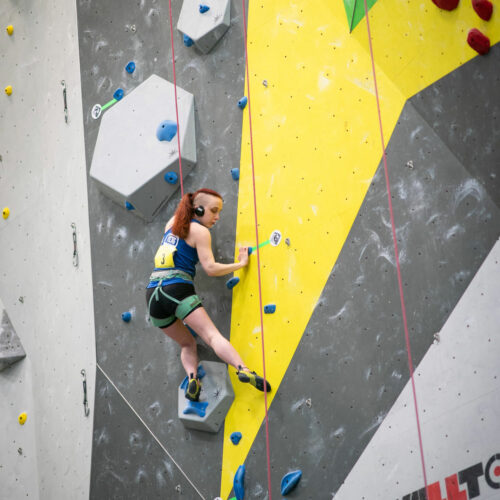
Understanding Paraclimbing Categories
Athlete impairments vary wildly, and at USAC and IFSC competitions—which typically take place on roped walls—categories are created to group similarly-abled climbers together. Each category is based on the type of impairment the athletes have, and then the relative severity of that impairment. The different categories are labeled with a letter abbreviation that indicates the type of athlete impairment, and then a number to designate the severity. In general, the lower the number, the more severe the impairment. (Note: In this article, we will not discuss the youth category.)
- Visual Impairment (B1, B2, B3)
- Upper Extremity Amputee (AU1, AU2)
- Lower Extremity Amputee (AL2), Seated (AL1)
- Range of Power (RP1, RP2, RP3)
- Youth
Unlike other competitions, climbers can be moved into different categories at the last minute. “Athletes self-classify when they sign up, but then they are seen by a medical doctor before the competition, and they get classified into what classification they are going to compete at,” says Haeckel. “They may think they are B3, but get classified into B1 that morning.”
Sanchez notes how complicated it can get for athletes when it comes to classifying. “Some of us are not just missing some of our limbs,” he says. “Some of us are dealing with visual impairment as well, or dealing with some sort of neurological disorder, where even though they have an amputation, their right side doesn’t work as strong. So where do they categorize? Where should they fall under?” Depending on how many athletes show up, categories are often blended together. This makes the challenge of fairness even greater, which brings it all back to a repeated but essential point—the setters need to know who they are setting for.
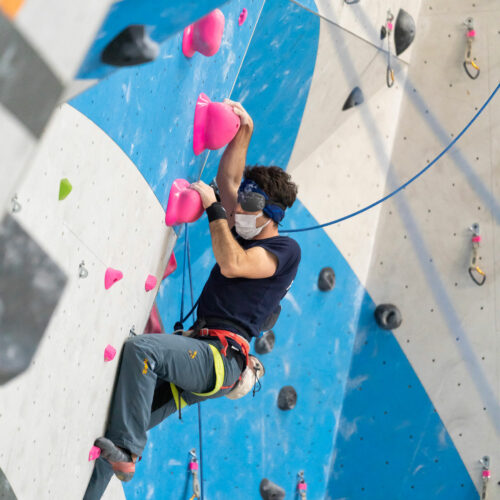
Visually Impaired (B)
The Visually Impaired category encompasses athletes with varying degrees of impairment to their visual acuity and visual field, from 5-20% visual acuity (B3), to fully blind climbers (B1). These athletes will often wear a headset, where they can listen to their sight guide—a person they train with, who is on the ground, talking the climbers through the upcoming movements. The guides often describe what type and direction of hold the athletes are moving to, and where it is in relation to their body.
“Climbers in this category climb very static,” says Mercer. “They lock off for extended periods of time searching/feeling for the next hold.” He also comments that placing feet on intricate footholds can be exceptionally challenging for B category climbers.
“We don’t want things that are super far away, that they will have to go to dynamically,” says Haeckel. However, he notes that each year the athletes progress further and further with what they are capable of. “Do I think there is room for dynamic movement? Absolutely. But that comes with pushing athletes.”
When setting for blind climbers, it’s important to remember a few key considerations. Most moves should be within the reach of the climbers, who will often lock off with one hand and reach for the next hold in the direction told to them by their guide. Precision moves, both for hands and feet, tend to be more difficult for blind climbers. And while there is room for pushing dynamic climbing, static climbing is the MO for most blind climbers, and should be in the back of a setter’s mind while creating movement.
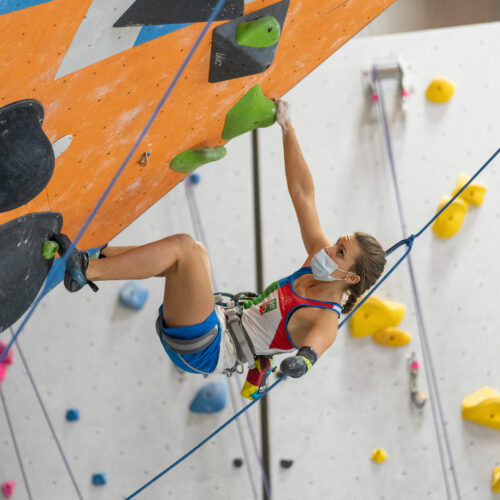
Upper Extremity Amputee (AU)
Upper Extremity Amputee climbers have an impairment on one of their upper limbs. The AU1 category is an arm amputee, and AU2 is a forearm amputee. The variations between impairments can be great, but in most cases the athletes will have some form of articulation at the joint. AU climbers often tape up and use their residual limb as their point of contact. “Just like climbers work their fingertips or their skin,” says Haeckel, “[AU climbers] will work that limb at the end to be able to bear down on things. They can get behind any edge.”
How different AU athletes might use any given hold can vary. “[These athletes] often climb with a very different sequence than that of an able-bodied climber,” says Mercer. “Arm amputees often lead with their intact limb and then match the hold with their residual limb.” Climbers are not placed into different groups based on what side of their body is affected.
For AU climbers, hold choice becomes very important. Depending on the impairment, an AU climber may have a different experience matching a large sloper compared to an able-bodied climber. Setters must understand not only how the AU climbers will interact with different types of holds―from big slopers, pinches and jugs to small crimps and edges―but how they might progress through a sequence and if the movement would favor climbers with impairments on one side over the other. Another thing to consider is that AU athletes have much smaller ape indexes than able-bodied climbers, meaning that setters need to be consciously aware of the distance between holds and how the climber is going to be interacting with those holds with their residual limb.
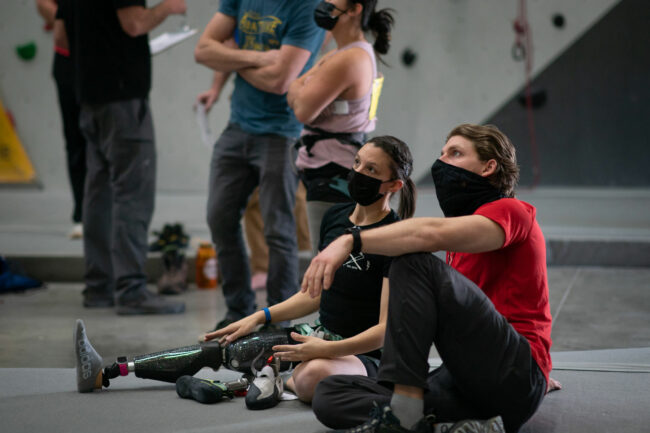
Lower Extremity Amputee (AL)
The Lower Extremity Amputee category includes leg amputees and seated climbers. Some of the climbers in the AL2 category climb with a prosthesis and some do not. “Movements requiring intricate footwork and placing weight on the feet can be hard to make fair when climbers might be missing different sides,” says Mercer.
Haeckel recalls that, just a few years ago, climbers were jumaring up a rope while sitting in a seat. “They approached Mark Mercer and said, ‘We’d like to campus up a route, we want to pull on holds.’” That conversation led to changes in the setting, which led to immense growth for the athletes and their capabilities. Now, campusing is the standard. “They are absolutely amazing at it now,” says Haeckel. “We learn something new about campusing every year.”
While setting for the AU2 category, it’s important to remember that any given move will feel different depending on which lower limb is missing. Sequences for AU athletes need to be functional and fair for both sides—a task that is often illuminated during the forerunning process.
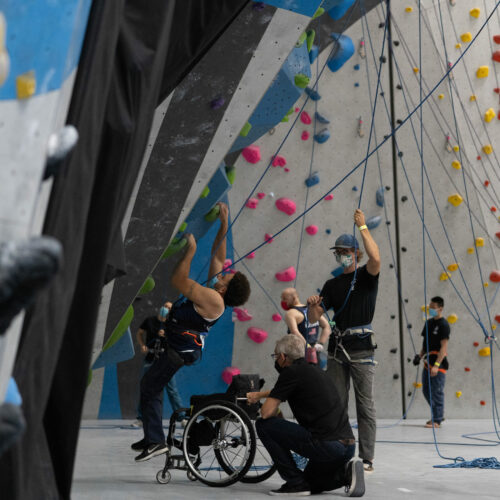
Range of Power (RP)
Range of Power is the most diverse category and includes disabilities involving challenges to climbers’ mobility, power and/or stability. This includes athletes with neurological disorders, partial paralysis, and congenital or acquired physical disabilities.
Because of the diversity of climbers in the Range of Power category, there are many factors to consider. “Some of these [conditions] may affect the climber’s motor functions or use of a particular part of the body,” says Mercer. Some climbers might have a condition that has affected the development of a limb, which could present similarly to climbers from the AL or AU categories. Other climbers might have full, limited or no use of their cores, which greatly affects what types of moves the setters can ask of them. Paraplegic climbers have no use of their legs and will fully campus the routes.
“We might see climbers with spinal cord injuries, Multiple Sclerosis, Cerebral Palsy, or Congenital and acquired physical disabilities,” says Mercer. Range of Power also includes athletes who have suffered from brain damage or a stroke. These climbers will often have issues with stability, which can affect the ability to use precise, accurate feet and hold tension throughout the body. With this much diversity within a single category, setters have to know the individual athletes and their impairments before they start setting.
Routes for these athletes can become functional and fair with higher consideration of footholds, both size and placement. A high-foot sequence that is fine for able-bodied climbers can be non-feasible for many RP athletes, as can moves on highly directional feet that involve a high deal of core tension.
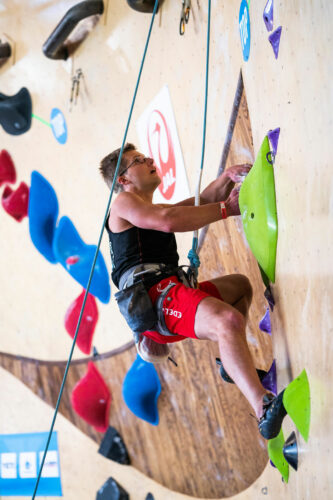
Forerunning for Paraclimbers
In setting for youth climbers, routesetters will “climb small” during forerunning to mimic the size of younger climbers. A similar mentality is applied when forerunning for paraclimbers. “We often mimic a paraclimber’s disability when forerunning,” says Mercer. “That might mean campusing a route intended for a paraplegic, only using one leg while forerunning for leg amputees, or keeping your eyes closed for the visually impaired.”
It’s important to note that this is an essential, yet imperfect, technique. Some disabilities are difficult to replicate, and there are countless body mechanics that are affected by any given impairment. “I have a certain style of climbing, you have a certain style of climbing, and people with any kind of impairment have their own style of climbing,” says Haeckel, “their own flow.”
When a setter attempts to mimic a disability in forerunning, it’s not the same as the athletes’ actual experiences. “When we are forerunning, we may forerun without a left leg,” says Haeckel. “It’s hard for us to do that, but also it doesn’t really replicate how they climb either, because…a lot of times they have a limb and they know how to use it very well.”
“Some disabilities are very hard to imitate,” says Mercer. “For instance, the way an arm amputee climber might grab a hold with their residual limb is very hard to replicate. I will usually feel the hold by placing my wrist on the hold and visualizing the body placement, but having a hand doesn’t allow me to truly grab the hold like an AU climber would. This is where experience and visualization really come into play.”
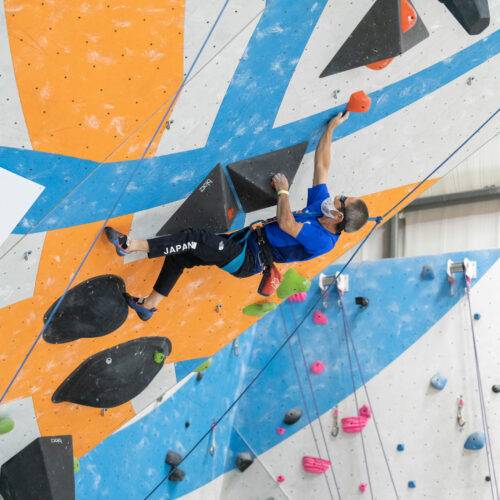
Safety
A huge part of any routesetter’s job is ensuring the relative safety of the climber. We all know climbing is an inherently dangerous sport, but some setting choices—like creating a low-percentage move on a slab over a huge, pointy volume, or choosing fingery, tweaky holds on the crux of beginner routes—can increase the relative danger for climbers. All of the normal safety-related decisions in routesetting apply to routesetting for paraclimbers, but there are a few additional considerations for the specific categories.
For example, for campusing, it’s essential to set on an overhang, so the climber isn’t dragging and scraping their body up the wall and holds and so that they fall safely into empty space when they fall. For some of the RP and AL athletes, their conditions dictate a very, very long time to heal from what many might consider run-of-the-mill climbing injuries, like a bruise on the hip from a swinging fall or a leg scrape on a volume. Falls or swings that might result in body impact against the wall are to be avoided. And for blind climbers, anything that requires quick sight-related reflexes, like using your feet to brace the wall on a pendulum-swinging fall, needs extra consideration.
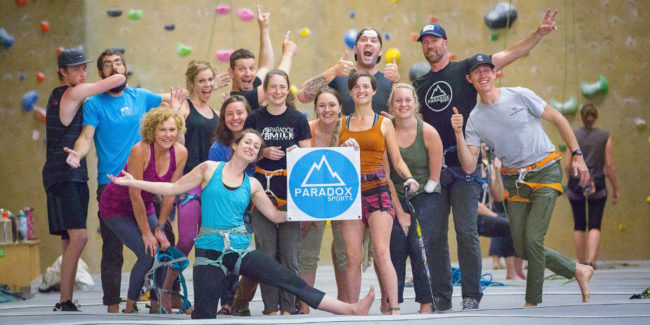
How to Get Into Setting for Paraclimbing
While Paraclimbing is indeed blossoming within the industry, many setters don’t have the chance to try these techniques because not every gym has paraclimbers as members. Getting into routesetting is often a non-linear path, and entering the paraclimbing scene can feel like a niche within an already niche community. The key for setters is more simple than it might seem:
In order to set for a paraclimbing community, we have to help that community grow.
According to the ADA, over 54 million Americans have a disability. The issue is not a lack of potential competitors and athletes—it’s in creating space for them within climbing. “The more people we get into climbing, the more people we invite—that’s the best way we can do it,” says Sanchez. “Inviting these people in and letting them know that everyone is welcome―focusing on programs like that is how we are going to create more [climbers] and more competitors.”
Tapping into local and regional adaptive communities is a great path in. “Invite local organizations of adaptive athletes, wounded veterans, and members with disabilities to your gym,” Mercer says. Haeckel echoes the same sentiment. “Everyone has the capability of being a climber. If you know anyone who is a para-athlete, you can introduce them to climbing and set for them that way.”
Sanchez highlights the importance of creating weekly meet-ups catered toward adaptive climbers, and hosting paraclimbing events that tap into athletes from a larger geographical region. He offers additional avenues, like reaching out to the adaptive programs at local colleges and schools, networking with local physical therapy offices, and tapping into government programs geared toward persons with disabilities. “We are not these special unicorn beings that can be easily destroyed,” he says. “Get us on the wall! Let us show you what we got. We will take it from there.”
For setters who want to set for USA Paraclimbing competitions, the best way is to get involved with the USAC setting program, which certifies setters for competition setting.
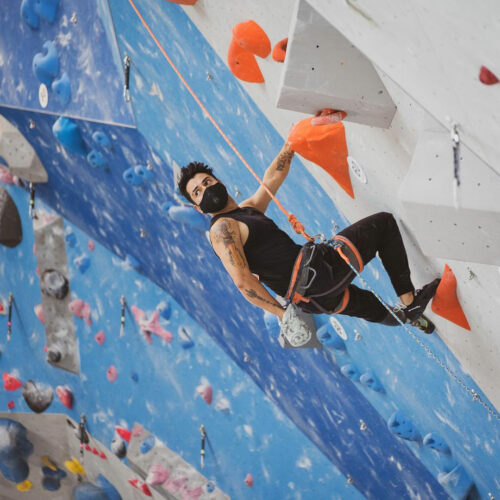
What Not to Forget
It’s not an easy task, to say the least. But as both Mercer and Haeckel reinforce, it’s no different than any other type of setting. It all comes back to the fundamental principle of knowing who you are setting for. At the local level, a huge piece of knowing and understanding who you are setting for is taking time to watch athletes. Seeing them climb, watching their movement, and understanding their flow will inform much of how to set for and challenge these athletes.
Whether it’s at the local or international level, setting for paraclimbers is an immensely rewarding experience for both setter and athlete. “The paraclimbing community is the most welcoming, positive group you will ever encounter,” says Mercer. “The amount of support for one another, even during competition, just isn’t found anywhere else.”
“Yes, it’s a competition and we all have goals,” says Sanchez. “We all have dreams that we want to make it to the top. We are competitive. But we are also just stoked to be there. We all found climbing, and it changed us.”

Jonathan has been climbing for ten years and routesetting for half as long. He is a former magazine editor, and his writing spans from marketing content and journalism to speculative fiction. When he’s not writing or bolting plastic to plywood, he’s probably outside somewhere, hiking, climbing, or surfing poorly. He’s been known, on occasion, to drop everything and travel the world for months at a time.




